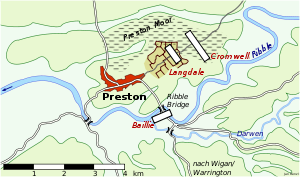Second English Civil War
| Second English Civil War | |||||||
|---|---|---|---|---|---|---|---|
| Part of the English Civil War | |||||||
 Map showing the site of the Battle of Preston (1648) |
|||||||
|
|||||||
| Belligerents | |||||||
|
Royalist forces Scotland |
Parliamentary forces | ||||||
| Commanders and leaders | |||||||
|
Duke of Hamilton Earl of Norwich Lord Capel |
Oliver Cromwell Thomas Fairfax Thomas Horton |
||||||
The Second English Civil War (1648–1649) was the second of three wars known collectively as the English Civil War (or Wars), which refers to the series of armed conflicts and political machinations which took place between Parliamentarians and Royalists from 1642 until 1651 and also include the First English Civil War (1642–1646) and the Third English Civil War (1649–1651).
The end of the First Civil War, in 1646, left a partial power vacuum in which any combination of the three English factions, Royalists, Independents of the New Model Army (sometimes called the "Commonwealth Army", henceforward called "the Army"), and Presbyterians of the English Parliament, as well as the Scottish Parliament allied with the Scottish Presbyterians (the "Kirk"), could prove strong enough to dominate the rest. Armed political Royalism was at an end, but despite being a prisoner, King Charles I (1600–1649) was considered by himself and his opponents (almost to the last) as necessary to ensure the success of whichever group could come to terms with him. Thus he passed successively into the hands of the Scots, the Parliament and the Army. The King attempted to reverse the verdict of arms by "coquetting" with each in turn. On 3 June 1647 Cornet George Joyce of Thomas Fairfax's horse seized the King for the Army, after which the English Presbyterians and the Scots began to prepare for a fresh civil war, less than two years after the conclusion of the first, this time against "Independency", as embodied in the Army. After making use of the Army's sword, its opponents attempted to disband it, to send it on foreign service and to cut off its arrears of pay. The result was that the Army leadership was exasperated beyond control, and, remembering not merely their grievances but also the principle for which the Army had fought, it soon became the most powerful political force in the realm. From 1646 to 1648 the breach between Army and Parliament widened day by day until finally the Presbyterian party, combined with the Scots and the remaining Royalists, felt itself strong enough to begin a Second Civil War.
...
Wikipedia
